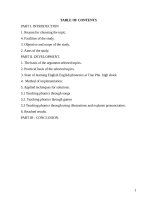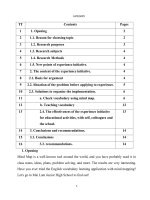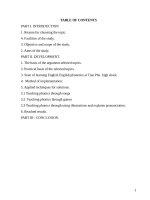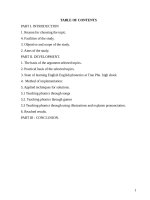Teaching English Intonation to EF1
Bạn đang xem bản rút gọn của tài liệu. Xem và tải ngay bản đầy đủ của tài liệu tại đây (142.34 KB, 12 trang )
Teaching English Intonation to EFL/ESL
Students
Mehmet Celik
This article proposes a workable, teachable, generalisable as well as communicatively
efficient framework for the teaching of the intonation of English to non-native speakers of
English. It is proposed that a framework of English intonation should include four major
intonational features: intonation units, stress, tones, and pitch range. Consequently, the
phenomena of intonation in English should have a piece of utterance, intonation unit, as its
basis to study all kinds of voice movements and features. Every intonation unit has a type
of tonic stress: (unmarked) utterance-final tonic stress, or emphatic, or contrastive, or new
information stress, the last of which is more frequently used in utterances given to wh-
questions. Further, intonation units have typically one of these tones; fall, low-rise, high-
rise, and fall-rise. Tones are assigned to intonation units in relation to the type of voice
movement on the tonic syllable. Finally, all intonation units have to be spoken in one of the
three pitch levels (keys): high, mid, and low.
Introduction
At a time when the language learning task is geared to instant interpersonal communication
with efficiency and precision, the intonation phenomena could not have gone unnoticed in
the preparation of English teaching syllabuses in the threshold of a new millennium. What
to include and what not to in the teaching of intonation to learners of English as a
second/foreign language (ESL/EFL) has caused uncertainty and lack of confidence, and
consequently ignoring of the intonation in syllabuses to a great extent, which is, as
Underhill (1994:75) rightly notes, because '...we are not in control of a practical, workable
and trustworthy system through which we can make intonation comprehensible.'
A major feature of communication, suprasegmental (prosodic) features of speech have
usually been avoided in the design of syllabuses for teaching English, partly due to the
unduly little importance attached to the teaching of them, and partly due to the
unavailability of a concise, salient, practical, and workable framework (Underhill, 1994:47;
Kenworthy, 1987). There are some attempts, of course, to come up with a scheme that is
practical. However, they usually concentrate on certain areas of intonation rather than
embracing the whole phenomenon of intonation (Coulthard, 1977; Underhill, 1994; Levis,
1999). Levis (1999), for instance, falls short of providing a coherent scheme by which
foreign language teachers can utilize in their syllabuses for improving oral skills; it studies,
in passing, intonational features such as significant pitch, pitch levels, intonation patterns,
and placement of nuclear stress.
For Cruttenden (1986:35), intonation has three important features: 1) : division of a
(dividing) a stream of speech into intonation units, 2) selection of a syllable (of a word),
which is assigned the 'tonic' status, and 3) selection of a tone for the intonation unit To this
list, another feature can be added: pitch range, or key (Brazil et al., 1980). In the experience
of the present author in teaching oral skills to prospective teachers of English as a
second/foreign language, a conception incorporating these four major features of intonation
in the teaching syllabus has efficiently worked and proved very useful. This system, it is
believed, may prove to be useful for other practitioners in the field of ESL/EFL.
This article explains the four major features in the teaching of English suprasegmentals:
intonation units, stress, tone, and pitch range by reviewing relevant and current research.
As such, this article provides a framework of English intonation for the teaching of English
as a second/foreign language. What the framework proposes is primarily based on what is
most salient in the more recent scholarly studies of intonation phenomena, and secondarily,
on what can be teachable given the author's own experience in the teaching of the
phenomena. Later, the need to teach intonational features in meaningful contexts with
realistic language rather than fabricated language as well as the need to consider intonation,
not as a luxury but a necessity for an efficient interchange in English is pointed out.
Intonation Units
An 'intonation unit' is a piece of utterance, a continuous stream of sounds, bounded by a
fairly perceptible pause. Pausing in some sense is a way of packaging the information such
that the lexical items put together in an intonation unit form certain psychological and
lexic~grammatical realities. Typical examples would be the inclusion of subordinate
clauses and prepositional phrases in intonation units.
It is proposed here that any feature of intonation should be analyzed and discussed against
a background of this phenomenon: tonic stress placement, choke of tones and keys are
applicable to almost all intonation units. Closely related with the notion of pausing is that a
change of meaning may be brought about; certain pauses in a stream of speech can have
significant meaning variations in the message to be conveyed. Consider the example below,
in which slashes correspond to pauses (Roach, 1983:146) (see Halliday, 1967; Leech &
Svartvik, 1975 for more): the meaning is given in brackets.
• Those who sold quickly / made a profit
(A profit is made by those who sold quickly.)
• Those who sold / quickly made a profit
(A profit was quickly made by those who sold.)
More examples can be used in order to illustrate the significance of pausing, and further, it
can be pointed out that right pausing may become a necessity to understand and to be
understood well.
Stress
This section addresses the notion of stress in words as perceived in connected speech. In
addition, the existence and discovery of tonic stress is discussed, and the major types of
stress are explicated. Four major types of stress are identified:
• unmarked tonic stress
• emphatic stress
• contrastive stress
• new information stress
An important prosodic feature, 'stress' applies to individual syllables, and involves, most
commonly, loudness, length, and higher pitch (Roach, 1983:73). Each of these features
may contribute in differing degrees at different times. Stress is an essential feature of word
identity in English (Kenworthy, 1987:18). It is evident that not all syllables of a
polysyllabic English word receive the same level of stress; in connected speech, usually
two levels of stress appear to be perceptible, to non-native speakers in particular, regardless
of the number of syllables: stressed and unstressed (Ladefoged, 1973; Kenworthy, 1987).
What is known as the primary stress is regarded as the stressed syllable while the rest,
secondary, tertiary, and weak, are rendered as unstressed syllables.
At the clausal level, normally, words that carry higher information content in the utterance
are given higher stress than those carrying lower input (information) and those that are
predictable in the context. It is generally the case that one word is stressed more than any
other since it possesses the highest information content for the discourse utterance, that is,
it informs the hearer most. The group of words described above are largely from what is
called 'content' words as opposed to 'function' words. Content words are nouns, verbs,
adjectives, and adverbs while function words are articles, prepositions, conjunctions, and
modal auxiliaries. Furthermore, it is content words that are polysyllabic, not function
words. This classification conforms to grammatical considerations. The classification we
present here from a suprasegmental viewpoint, that is on the basis of being stressed or not,
is slightly different from that of grammar. Consider the following:
Content/Stressed Words Function/Unstressed Words
verbs modal auxiliaries
nouns articles
adjectives conjunctions
adverbs prepositions
question words pronouns
prepositional adverbs
negatives
In other words, the items on the left hand column are stressable in unmarked utterances
whereas the ones on the right column are not.
Tonic Stress
An intonation unit almost always has one peak of stress, which is called 'tonic stress', or
'nucleus'. Because stress applies to syllables, the syllable that receives the tonic stress is
called 'tonic syllable'. The term tonic stress is usually preferred to refer to this kind of stress
in referring, proclaiming, and reporting utterances. Tonic stress is almost always found in a
content word in utterance final position. Consider the following, in which the tonic syllable
is underlined:
• I'm going.
• I'm going to London.
• I'm going to London for a holiday.
A question does arise as to what happens to the previously tonic assigned syllables. They
still get stressed, however, not as much as the tonic syllable, producing a three level stress
for utterances. Then, the following is arrived at., where the tonic syllable is further
capitalized:
• I'm going to London for HOliday.
Emphatic Stress
One reason to move the tonic stress from its utterance final position is to assign an
emphasis to a content word, which is usually a modal auxiliary, an intensifier, an adverb,
etc. Compare the following examples. The first two examples are adapted from. Roach
(1983:144).
i. It was very BOring. (unmarked)
ii. It was VEry boring. (emphatic)
i. You mustn't talk so LOUDly. (unmarked)
ii. You MUSTN'T talk so loudly. (emphatic)
Some intensifying adverbs and modifiers (or their derivatives) that are emphatic by nature
are (Leech & Svartvik, 1.975:135):
indeed, utterly, absolute, terrific, tremendous, awfully, terribly, great, grand, really,
definitely, truly, literally, extremely, surely, completely, barely, entirely, very (adverb),
very (adjective), quite, too, enough, pretty, far, especially, alone, only, own, -self.
Contrastive Stress
In contrastive contexts, the stress pattern is quite different from the emphatic and non-
emphatic stresses in that any lexical item in an utterance can receive the tonic stress
provided that the contrastively stressed item can be contrastable in that universe of speech.
No distinction exists between content and function words regarding this. The contrasted
item receives the tonic stress provided that it is contrastive with some lexical element
(notion.) in the stimulus utterance. Syllables that are normally stressed in the utterance
almost always get the same treatment they do in non-emphatic contexts. Consider the
following examples:
a) Do you like this one or THAT one?
b) I like THIS one.
Many other larger contrastive contexts (dialogues) can be found or worked out, or even
selected from literary works for a study of contrastive stress. Consider the following:
She played the piano yesterday. (It was her who...)
She played the piano yesterday. (She only played (not. harmed) ...)
She played the piano yesterday. (It was the piano that...)
She played the piano yesterday. (It was yesterday...)
New Information Stress
In a response given to a wh-question, the information supplied, naturally enough, is
stressed,. That is, it is pronounced with more breath force, since it is more prominent
against a background given information in the question. The concept of new information is
much clearer to students of English in responses to wh-questions than in declarative
statements. Therefore, it is best to start with teaching the stressing of the new information
supplied to questions with a question word:
a) What's your NAME
b) My name's GEORGE.
a) Where are you FROM?
b) I'm from WALES.
a) Where do you LIVE
b) I live in BONN
a) When does the school term END
b) It ends in MAY.
a) What do you DO
b) I'm a STUdent.
The questions given above could also be answered in short form except for the last one, in
which case the answers are:
• George,
• Wales,
• in Bonn
• in May
In other words, 'given' information is omitted, not repeated. In the exchange:
a) What's your name?
b) (My name's) George.
The 'new' information in this response is 'George.' The part referring to his name is given in
the question, so it may be omitted.









